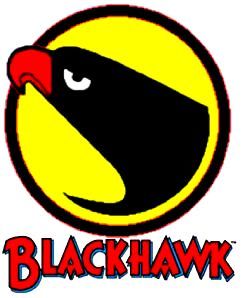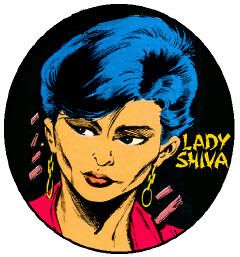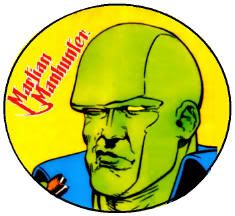 Mark Millar is a popular comic book writer who has managed to get many of his creator-owned properties optioned and even made (Wanted, Kick-Ass) with their storytelling aesthetic relatively intact. On the other end of the spectrum, 20th Century Fox (the Bryan Singer entries in the X-Men franchise notwithstanding) has a reputation for showing little regard for comic book properties, as proven by the lukewarm reviews and box office receipts for the Daredevil and Fantastic Four flicks. Marvel Studios are now breaking records with their multiple successful franchises, so FOX hired Mark Millar as their "superhero creative consultant," and in this role he's decided to run down DC's super-hero properties as out of date and otherwise too silly to thrive in a SciFiNow interview. I personally don't have much regard for Millar as a creator, and absolutely no faith in him as a media figure. He's repeatedly shown a willingness to lie his face off for industry ink, and I suspect he'll ultimately have as much creative input in FOX's movies as Stan Lee. That having been said, it doesn't mean he's not right about the irrelevancy of most DC properties.
There was a time when DC Comics was king of all super-hero media. The breakout comic book stars in the earliest days of the medium all got themselves adapted elsewhere. Whether it was newspaper strips, radio shows, or serials, many of the vanguard entered and remained in the public consciousness for decades. Superman starred in all three of the platforms mentioned, plus some of the most revered cartoons of all time. The Adventures of Superman TV show ran six beloved seasons before the suicide of star George Reeves halted production. Regardless, Superman became a fixture in television animation until the late 1980s. The feature films started rolling out in 1979, of which four were produced in the original run (two of them outright blockbusters.) Superman and his younger self Superboy headlined multiple TV programs of varying degrees of success from the '80s through to just a few years ago. Superman has always tended to be the crown jewel of super-hero adaptations, or at least he was until 1989, and he's surely still the biggest draw in live action television.
Mark Millar is a popular comic book writer who has managed to get many of his creator-owned properties optioned and even made (Wanted, Kick-Ass) with their storytelling aesthetic relatively intact. On the other end of the spectrum, 20th Century Fox (the Bryan Singer entries in the X-Men franchise notwithstanding) has a reputation for showing little regard for comic book properties, as proven by the lukewarm reviews and box office receipts for the Daredevil and Fantastic Four flicks. Marvel Studios are now breaking records with their multiple successful franchises, so FOX hired Mark Millar as their "superhero creative consultant," and in this role he's decided to run down DC's super-hero properties as out of date and otherwise too silly to thrive in a SciFiNow interview. I personally don't have much regard for Millar as a creator, and absolutely no faith in him as a media figure. He's repeatedly shown a willingness to lie his face off for industry ink, and I suspect he'll ultimately have as much creative input in FOX's movies as Stan Lee. That having been said, it doesn't mean he's not right about the irrelevancy of most DC properties.
There was a time when DC Comics was king of all super-hero media. The breakout comic book stars in the earliest days of the medium all got themselves adapted elsewhere. Whether it was newspaper strips, radio shows, or serials, many of the vanguard entered and remained in the public consciousness for decades. Superman starred in all three of the platforms mentioned, plus some of the most revered cartoons of all time. The Adventures of Superman TV show ran six beloved seasons before the suicide of star George Reeves halted production. Regardless, Superman became a fixture in television animation until the late 1980s. The feature films started rolling out in 1979, of which four were produced in the original run (two of them outright blockbusters.) Superman and his younger self Superboy headlined multiple TV programs of varying degrees of success from the '80s through to just a few years ago. Superman has always tended to be the crown jewel of super-hero adaptations, or at least he was until 1989, and he's surely still the biggest draw in live action television.
 Batman was also an early adopter of multi-platforming, including his own serial, and later, the cultural phenomenon dubbed "Batmania" that spawned a hugely successful TV show and feature film. Batman had a spottier track record in animation, though. However, a second wave of Batmania launched with Tim Burton's 1989 movie, from which three sequels were born, and one of the most endearing cartoons ever, Batman: The Animated Series. Only Spider-Man has ever challenged the Dark Knight as champion of comic book box office, though the bofo business of the Christopher Nolen film trilogy helped pull the Caped Crusader that much further ahead. Batman has also dominated animation, with more cartoons than I care to count.
Batman was also an early adopter of multi-platforming, including his own serial, and later, the cultural phenomenon dubbed "Batmania" that spawned a hugely successful TV show and feature film. Batman had a spottier track record in animation, though. However, a second wave of Batmania launched with Tim Burton's 1989 movie, from which three sequels were born, and one of the most endearing cartoons ever, Batman: The Animated Series. Only Spider-Man has ever challenged the Dark Knight as champion of comic book box office, though the bofo business of the Christopher Nolen film trilogy helped pull the Caped Crusader that much further ahead. Batman has also dominated animation, with more cartoons than I care to count.
 The 1970s were the pinnacle of DC Comics' cultural relevancy. Wonder Woman and Captain Marvel each had well liked live action shows, but the true jewel was the animated Super Friends. Ten seasons were produced over thirteen years, and the iconic Superman, Batman, Robin and Wonder Woman were each represented. Aquaman, who had his own single season cartoon in the 1960s, became synonymous with oceanic heroics (and the first Super Friends season even listed him as one of "the world's four greatest heroes.") The show (re)introduced general audiences to the Flash ("the" super-speed hero of record,) Green Lantern, Hawkman & Hawkgirl, the Atom, Firestorm, and Cyborg. There was also a slew of heroes created specifically for the show who are remembered today, like Black Vulcan, Apache Chief and the Wonder Twins. Plastic Man even managed to score his own spin-off show for a couple of seasons. In the 1970s, "super-heroes" were synonymous to "Super Friends," and there was very little competition from outside the DC ranks.
The 1970s were the pinnacle of DC Comics' cultural relevancy. Wonder Woman and Captain Marvel each had well liked live action shows, but the true jewel was the animated Super Friends. Ten seasons were produced over thirteen years, and the iconic Superman, Batman, Robin and Wonder Woman were each represented. Aquaman, who had his own single season cartoon in the 1960s, became synonymous with oceanic heroics (and the first Super Friends season even listed him as one of "the world's four greatest heroes.") The show (re)introduced general audiences to the Flash ("the" super-speed hero of record,) Green Lantern, Hawkman & Hawkgirl, the Atom, Firestorm, and Cyborg. There was also a slew of heroes created specifically for the show who are remembered today, like Black Vulcan, Apache Chief and the Wonder Twins. Plastic Man even managed to score his own spin-off show for a couple of seasons. In the 1970s, "super-heroes" were synonymous to "Super Friends," and there was very little competition from outside the DC ranks.
 The problem with being at the vanguard of a movement is that you tend to get as far out ahead of everyone in mistakes as you do with innovations. The DC shows were corny all-ages entertainment, but Superman, Batman, Wonder Woman and the Justice League as a whole descended into outright camp at various points in their careers, and no one lets them forget it (except Batman.) Awful Marvel outings like the Nicholas Hammond Spider-Man show and the TV movies of Doctor Strange and Captain America are largely forgotten, but it's tough to ever live down the self-parody of Superman III, Batman and Robin or Legends of the Superheroes. Marvel Comics in particular learned a lot from DC's missteps, and always managed to stay hipper and edgier than the Distinguished Competition. The modern age of Marvel films started with the R-rated Wesley Snipes Blade franchise, after all, and Marvel Studios has yet to have as catastrophic a blunder as the painfully boring Superman Returns.
The problem with being at the vanguard of a movement is that you tend to get as far out ahead of everyone in mistakes as you do with innovations. The DC shows were corny all-ages entertainment, but Superman, Batman, Wonder Woman and the Justice League as a whole descended into outright camp at various points in their careers, and no one lets them forget it (except Batman.) Awful Marvel outings like the Nicholas Hammond Spider-Man show and the TV movies of Doctor Strange and Captain America are largely forgotten, but it's tough to ever live down the self-parody of Superman III, Batman and Robin or Legends of the Superheroes. Marvel Comics in particular learned a lot from DC's missteps, and always managed to stay hipper and edgier than the Distinguished Competition. The modern age of Marvel films started with the R-rated Wesley Snipes Blade franchise, after all, and Marvel Studios has yet to have as catastrophic a blunder as the painfully boring Superman Returns.
 Diversity was the stone that slayed the Goliath that was DC Comics. From the cancellation of Super Friends in 1986 until the launch of the Cartoon Network's Justice League in 2001, DC simply shifted back and forth between Superman and Batman in live action and animation. Even if Marvel had been satisfied with the enormous success of Spider-Man and the X-Men, the latter still provided teams of spin-off characters to exploit. Yet, instead of resting on their laurels, Marvel consistently pushed to expand their universe of brands, from the Fantastic Four and Iron Man to the Hulk and the Avengers. The Punisher could shed all the blood he wanted while Captain America kept things clean and nostalgic. Everybody got their own super-hero with Marvel, while DC only had the World's Finest white men in capes. They didn't even bother to sustain all the multicultural icons from Super Friends after the cartoon died, taking a bold initiative of inclusion, then freezing it in amber as a comical example of feel-good post-hippie liberalism. People who've never read a comic book in their lives have had regular opportunities to get to know Storm, while El Dorado is only a vaguely recalled Generation X trivia question/punchline.
Click To Enlarge
Diversity was the stone that slayed the Goliath that was DC Comics. From the cancellation of Super Friends in 1986 until the launch of the Cartoon Network's Justice League in 2001, DC simply shifted back and forth between Superman and Batman in live action and animation. Even if Marvel had been satisfied with the enormous success of Spider-Man and the X-Men, the latter still provided teams of spin-off characters to exploit. Yet, instead of resting on their laurels, Marvel consistently pushed to expand their universe of brands, from the Fantastic Four and Iron Man to the Hulk and the Avengers. The Punisher could shed all the blood he wanted while Captain America kept things clean and nostalgic. Everybody got their own super-hero with Marvel, while DC only had the World's Finest white men in capes. They didn't even bother to sustain all the multicultural icons from Super Friends after the cartoon died, taking a bold initiative of inclusion, then freezing it in amber as a comical example of feel-good post-hippie liberalism. People who've never read a comic book in their lives have had regular opportunities to get to know Storm, while El Dorado is only a vaguely recalled Generation X trivia question/punchline.
Click To Enlarge
Justice League arrived rather late to the party, and any progress it made in modernizing the image of the DC heroes was undercut by the more broadly seen and utterly ridiculous Smallville. When DC had the opportunity to inject racial diversity into their image through the cartoon's John Stewart, film audiences were instead "treated" to Ryan Reynolds as Hal Jordan in the expensive flop Green Lantern. The media ambassadors of the DC Universe have by and large been low rent and goofy as hell, which means that with the exception of Batman, it's an uphill climb to get any of their heroes taken seriously. Superman was on a dumb show and in an dull movie. Wonder Woman was the least appealing female on a basic cable group cartoon. Aquaman was a running gag on Entourage and remains low hanging fruit for stand-up comics. The Flash dies after one expensive season against Cosby. No one even wants to bring up Robin anymore. Somehow, Warner Brothers has managed to be so myopic and misguided in their shepherding of the DC Universe, that Thor and Guardians of the Galaxy are perceived as more viable than most of their super-heroes. It'll take something beyond excessive piping and the abandonment of overgarments to dig them out of their present hole.

















No comments:
Post a Comment